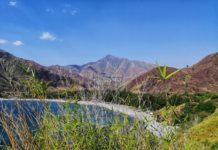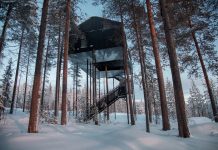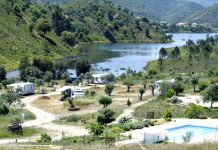Wapusk National Park was established back in 1996 and offers a total of 2,836,000 acres of beautiful countryside in the Canadian province of Manitoba. Many visitors come here to watch baby polar bear cubs in February as they wander out into the snow for the first time under the protective eyes of their loving mothers.
In fact, most visitors to the park show up to get a close up look at the wonderful wildlife that roams there. This huge park is made up of rugged subarctic forest and has its share of peat bog, making it a popular location with polar bears. The name Wapusk means white bear in the native Cree language.
 (photo credit: emmabishop)
(photo credit: emmabishop)
The polar bears usually arrive at the end of October after waiting in the forests for the local waterways to freeze up. They then travel through the Cape Churchill area of the park and head to the fresh ice. It’s estimated that about a thousand of them hang around on the frozen bay waters during the winter and feed on seals. They eat enough during the winter so they can survive the lean summers. Once in a while, you may also see the odd grizzly bear roaming around in the park.
Wapusk National Park is also home to numerous types of rare birds, as well as wolves, moose, arctic foxes, red foxes, lemmings, wolverines, and caribou. The weather can be bitterly cold in the winter, but local natives still follow their tradition of caribou hunting to feed themselves during these cold months. When the summer comes and the snow and ice thaw, the marshy wetlands and peat bogs can be pretty hard to navigate safely.
However, in the subarctic forest region, the ground is quite a bit firmer and you’ll find small trees which can often live to a few hundred years of age. These trees are just over 6 feet in height and their branches face south only due to the constant winds that come from the north. The shoreline of the park lies next to Hudson Bay, and it’s filled with flats, rocky beaches, and salt marshes.
You can visit the park by guided trips as there are several licensed tour operators in the region. These will take you to the Cape Churchill Wildlife Management Area, where you’ll be able to see a wide variety of animals and rare birds. It’s estimated that there are at least 250 different bird species along the coastline with many of them nesting here or stopping to feed while migrating somewhere else.
Some of the birds you may spot include great grey owls, Caspian terns, stilt sandpipers, sandhill cranes, Hudsonian godwits, snow geese, arctic loons, Canada geese, gyrfalcons, peregrine falcons, and Ross’s and ivory gulls.
You can reach the park by flying from Winnipeg to Churchill, Manitoba, or by taking the train. You’ll be able to see the polar bears each winter and the small cubs can be seen in the denning areas between mid-February and mid-March. You can get to the park by helicopter in the summer when you can enjoy wildlife tours as well as tundra hiking.
If you head back to Churchill, you’ll see beluga whales in the month of July along with their baby calves. If you plan on hiking in the Churchill area, you should go with a trained guide due to the possibility of meeting up with a stray polar bear. It’s not unusual to find these huge, magnificent creatures wandering around the city. You have to visit the park by guided tour as individual visitors aren’t allowed due to safety reasons.










